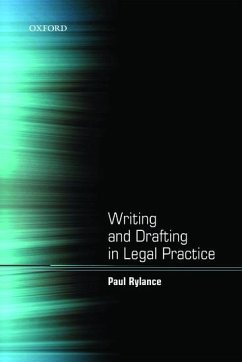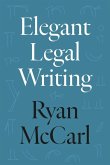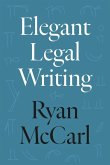Paul Rylance (Legal training consultant)
Writing and Drafting in Legal Practice
Paul Rylance (Legal training consultant)
Writing and Drafting in Legal Practice
- Broschiertes Buch
- Merkliste
- Auf die Merkliste
- Bewerten Bewerten
- Teilen
- Produkt teilen
- Produkterinnerung
- Produkterinnerung
A comprehensive guide to writing and drafting from the first stage of preparation to the final edit. Features checklists, worked examples and chapters on using email, and designed to accompany readers from vocational study through to their qualification as solicitors as well as throughout the early years of practice.
Andere Kunden interessierten sich auch für
![Elegant Legal Writing Elegant Legal Writing]() Ryan McCarlElegant Legal Writing30,99 €
Ryan McCarlElegant Legal Writing30,99 €![Elegant Legal Writing Elegant Legal Writing]() Ryan McCarlElegant Legal Writing85,99 €
Ryan McCarlElegant Legal Writing85,99 €![Learning Legal Rules Learning Legal Rules]() James Holland (Professor Emeritus, Professor Emeritus, Bristol LawLearning Legal Rules50,99 €
James Holland (Professor Emeritus, Professor Emeritus, Bristol LawLearning Legal Rules50,99 €![Opinion Writing and Case Preparation Opinion Writing and Case Preparation]() The City Law SchoolOpinion Writing and Case Preparation49,99 €
The City Law SchoolOpinion Writing and Case Preparation49,99 €![Legal Systems & Skills Legal Systems & Skills]() Scott Slorach (Professor and Director of Learning & Profe TeachingLegal Systems & Skills68,99 €
Scott Slorach (Professor and Director of Learning & Profe TeachingLegal Systems & Skills68,99 €![The Successful Law Student: An Insider's Guide to Studying Law The Successful Law Student: An Insider's Guide to Studying Law]() Imogen Moore (Professor of Law and Director of Education in the LawThe Successful Law Student: An Insider's Guide to Studying Law43,99 €
Imogen Moore (Professor of Law and Director of Education in the LawThe Successful Law Student: An Insider's Guide to Studying Law43,99 €![Legal Skills Legal Skills]() Emily Finch (Senior Lecturer in Law, Senior Lecturer in Law, UniverLegal Skills38,99 €
Emily Finch (Senior Lecturer in Law, Senior Lecturer in Law, UniverLegal Skills38,99 €-
-
-
A comprehensive guide to writing and drafting from the first stage of preparation to the final edit. Features checklists, worked examples and chapters on using email, and designed to accompany readers from vocational study through to their qualification as solicitors as well as throughout the early years of practice.
Produktdetails
- Produktdetails
- Verlag: Oxford University Press
- Seitenzahl: 328
- Erscheinungstermin: 2. Februar 2012
- Englisch
- Abmessung: 232mm x 156mm x 20mm
- Gewicht: 510g
- ISBN-13: 9780199589890
- ISBN-10: 0199589895
- Artikelnr.: 42354407
- Herstellerkennzeichnung
- Libri GmbH
- Europaallee 1
- 36244 Bad Hersfeld
- gpsr@libri.de
- Verlag: Oxford University Press
- Seitenzahl: 328
- Erscheinungstermin: 2. Februar 2012
- Englisch
- Abmessung: 232mm x 156mm x 20mm
- Gewicht: 510g
- ISBN-13: 9780199589890
- ISBN-10: 0199589895
- Artikelnr.: 42354407
- Herstellerkennzeichnung
- Libri GmbH
- Europaallee 1
- 36244 Bad Hersfeld
- gpsr@libri.de
Following seven years of practice at the bar and teaching law, Paul Rylance spent over seven years as Head of Education and Training with Slaughter and May, and SJ Berwin. During this time he became the first Chariman of the Legal Education and Training Group. In 1996 he became an Associate Dean in the Law faculty at UWE, and went on to form the Bristol Institute of Legal Practice. After some thirteen years at UWE, Paul now concentrates on his consultancy practice providing training and consultancy service to a number of City and other leading firms in the South West of England and elsewhere.
Part 1. Plain English and the General Principles of Legal Writing and Drafting
1: Preparation
2: Sentences and Paragraphs
3: Punctuation
4: Sentence Construction and Grammar
5: Verbs
6: Words and Phrases
7: Avoid Redundant Words and Phrases
8: Repetition and Elegant Variation
9: Using the Right Words
10: Checking your Documents
Part 2. Letters, Emails and and Other Forms of Written Communication
11: Preparation
12: Form, Style and Layout Conventions
13: Letters: Language, Tone, Politeness and Humanity
14: Letters to Clients
15: Letters to Third Parties
16: Email
17: Email Policies
18: Email Etiquette
19: Email Writing
20: Internal Notes, Memoranda and Reports
21: Checking
Part 3. Drafting
22: Preparation and Taking Instructions
23: The Contents and Principal Clauses
24: Planning the Document
25: Layout Conventions and House Style
26: Construction
27: Expressions Relating to Time
28: Definitions
29: Use of Imprecise Words and the Burden of Proof
30: Standards of Obligation
31: Sentences and Paragraphs
32: Choice of Words
33: Final Considerations
1: Preparation
2: Sentences and Paragraphs
3: Punctuation
4: Sentence Construction and Grammar
5: Verbs
6: Words and Phrases
7: Avoid Redundant Words and Phrases
8: Repetition and Elegant Variation
9: Using the Right Words
10: Checking your Documents
Part 2. Letters, Emails and and Other Forms of Written Communication
11: Preparation
12: Form, Style and Layout Conventions
13: Letters: Language, Tone, Politeness and Humanity
14: Letters to Clients
15: Letters to Third Parties
16: Email
17: Email Policies
18: Email Etiquette
19: Email Writing
20: Internal Notes, Memoranda and Reports
21: Checking
Part 3. Drafting
22: Preparation and Taking Instructions
23: The Contents and Principal Clauses
24: Planning the Document
25: Layout Conventions and House Style
26: Construction
27: Expressions Relating to Time
28: Definitions
29: Use of Imprecise Words and the Burden of Proof
30: Standards of Obligation
31: Sentences and Paragraphs
32: Choice of Words
33: Final Considerations
Part 1. Plain English and the General Principles of Legal Writing and Drafting
1: Preparation
2: Sentences and Paragraphs
3: Punctuation
4: Sentence Construction and Grammar
5: Verbs
6: Words and Phrases
7: Avoid Redundant Words and Phrases
8: Repetition and Elegant Variation
9: Using the Right Words
10: Checking your Documents
Part 2. Letters, Emails and and Other Forms of Written Communication
11: Preparation
12: Form, Style and Layout Conventions
13: Letters: Language, Tone, Politeness and Humanity
14: Letters to Clients
15: Letters to Third Parties
16: Email
17: Email Policies
18: Email Etiquette
19: Email Writing
20: Internal Notes, Memoranda and Reports
21: Checking
Part 3. Drafting
22: Preparation and Taking Instructions
23: The Contents and Principal Clauses
24: Planning the Document
25: Layout Conventions and House Style
26: Construction
27: Expressions Relating to Time
28: Definitions
29: Use of Imprecise Words and the Burden of Proof
30: Standards of Obligation
31: Sentences and Paragraphs
32: Choice of Words
33: Final Considerations
1: Preparation
2: Sentences and Paragraphs
3: Punctuation
4: Sentence Construction and Grammar
5: Verbs
6: Words and Phrases
7: Avoid Redundant Words and Phrases
8: Repetition and Elegant Variation
9: Using the Right Words
10: Checking your Documents
Part 2. Letters, Emails and and Other Forms of Written Communication
11: Preparation
12: Form, Style and Layout Conventions
13: Letters: Language, Tone, Politeness and Humanity
14: Letters to Clients
15: Letters to Third Parties
16: Email
17: Email Policies
18: Email Etiquette
19: Email Writing
20: Internal Notes, Memoranda and Reports
21: Checking
Part 3. Drafting
22: Preparation and Taking Instructions
23: The Contents and Principal Clauses
24: Planning the Document
25: Layout Conventions and House Style
26: Construction
27: Expressions Relating to Time
28: Definitions
29: Use of Imprecise Words and the Burden of Proof
30: Standards of Obligation
31: Sentences and Paragraphs
32: Choice of Words
33: Final Considerations








